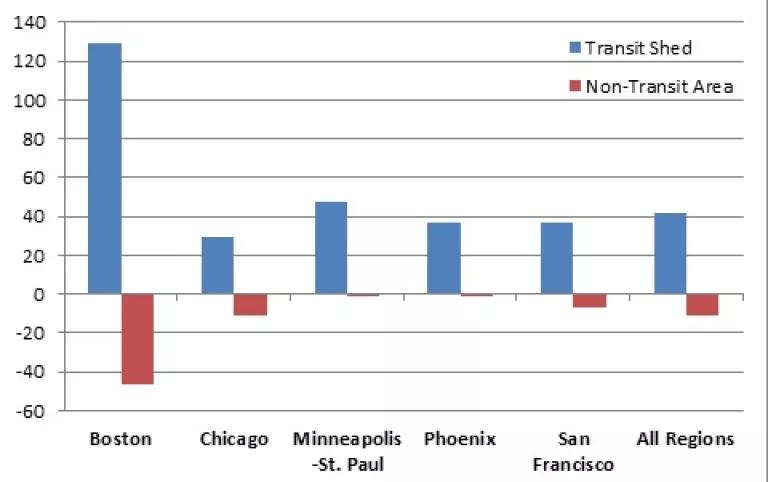The American Public Transportation Association (APTA, of which NRDC is a member) and the National Association of Realtors (NAR) rolled out a valuable addition to the lit on transportation today: A study of home-price performance near transit in five metro areas.
The top-line finding? Prices held up an average of 42 percent better from 2006-2011 if a home was located a mile or less from a transit stop.
The Center for Neighborhood Technology (CNT) actually did the analysis, combing through recorder of deeds sales prices and transit station locations for these metros. This is no mean feat, given the regions selected and the sheer number of stops (and the number of sales!):
- Boston: 134 commuter rail stations, 121 rapid transit stations and 35 bus rapid transit stations;
- Chicago: 240 commuter rail stations and 144 heavy rail stations;
- Minneapolis-St. Paul: 19 light rail stations and 6 commuter rail stations;
- Phoenix: 32 light rail stations; and
- San Francisco: 59 commuter rail stations (although only 28 are in the study area), 44 heavy rail stations, and 255 stations for light rail, cable cars and streetcars.
The findings of the study for each of the regions are summarized in the graph below, with the x axis set at the overall average residential home sales price for each region between 2006-2011.

The gap in Boston is a chasm, at 129 percent. Then, in order of gap size, Minneapolis-St. Paul (48 percent), San Francisco and Phoenix (37 percent) and Chicago (30 percent).
There's a lot of room for more research in this area moving forward. For example, an astute audience member at a briefing on this hosted by the Environmental and Energy Study Institute (EESI) today on Capitol Hill in D.C. (for presentations and forthcoming audio and video click here) noted that the study correlated home price changes but didn't delve into how large a causal role transit-proximate location played in the large gaps between home prices.
And while these five regions are well-chosen since they represent a variety of characteristics vis-a-vis geographical siting (NE, MW, SW and W) and transit system attributes (some old and big, some new and small), it would be interesting to now perform similar research in other metros. The good news is that APTA staff tell me that the organization plans to build on this with much more study in more regions.
The bad news is that such analysis needs to happen quickly given new federal policy.
Studies like this can be very useful for making the case that public transportation is valuable beyond monies collected at the farebox, and that value can be captured in innovative financing arrangements. Specifically, if land adjacent to transit stops is projected to increase dramatically in value, then those who own the land can and should ante up to help build the lines and stops that generate that value. This has happened in several places, including right here in D.C. around beautiful Union Station and the "NoMa" Metro stop (NoMa stands simply for "North of Massachusetts Avenue" a main thoroughfare here in D.C.). But there us much untapped value, around both current and future stops.
And there is a newly expanded program that can be tapped for this kind of public-private partnership in the new federal transportation bill: Transportation Infrastructure Finance and Innovation Act (TIFIA). This program ballooned eightfold in the new law, bringing billions of dollars in loans, loan guarantees and lines-of-credit to bear in creative financing arrangements. However, historically TIFIA has mostly funded tolled auto traffic facilities since its inception in 1998. And currently more than 2/3 of "letters of interest" in expanded financing under the new program are for -- you guessed it -- toll bridges or roads!
That's not innovative any more. Submerged-value capture for transit system expansions sure is, though. It's time for transit agencies -- plus local governments, since as someone else at the event today correctly noted they often own the surrounding property -- to reach out to private partners and hammer out proposals that surface the value with analyses such as this new APTA-NAR-CNT study.
I look forward to learning more about the hidden value of transit systems, and expansion proposals, across the country.



